KINSC 2021
The Marian E. Koshland Integrated Natural Sciences Center



The Marian E. Koshland Integrated Natural Sciences Center


at the leading edge of academic excellence in the sciences.
To achieve this end, the KINSC promotes scientific scholarship involving close collaboration between faculty and students and provides opportunities for these activities to expand beyond the borders of the Haverford campus.
The KINSC is unique among Haverford’s three academic centers in that it is both a building and a program. The 185,000 square foot building is the epicenter of natural science research at Haverford. It was constructed to facilitate sharing of ideas,
instruments, and expertise across disciplines and to contribute to a climate of cooperative problem solving and investigation.
The KINSC includes the departments of Astronomy, Biology, Chemistry, Physics, Psychology, Mathematics and Statistics, and Computer Science. To supplement the efforts of the departments, the KINSC supports interdisciplinary interactions. In addition to directly funding students and faculty, the Center supports academic activities initiated with outside grants and individual faculty awards.
The KINSC funds individual research projects and sponsors symposia, seminars, curricular initiatives, student conference and research travel, courses, and scholarly projects that go beyond the bounds of a single discipline and involve students and faculty from multiple departments.
Astronomy
Astrophysics
Biology
Chemistry
Chemistry – ACS Certified
Computer Science
Environmental Studies
Geology (at Bryn Mawr)
Interdisciplinary Physics
Mathematics
Neuroscience
Physics
Psychology
MINORS
Astronomy
Chemistry
Chemistry – ACS Certified
Computer Science
Environmental Studies
Health Studies
Mathematics
Neuroscience
Physics
Psychology
Statistics
CONCENTRATIONS
Biochemistry
Biophysics
Computer Science
Geoarchaeology (at Bryn Mawr)
Geochemistry (at Bryn Mawr)
Mathematical Economics
Mathematics Education
Scientific Computing
DEGREE PARTNERSHIPS
4+1 Bioethics with UPenn
Accelerated Masters in Engineering with UPenn
3+2 Engineering with CalTech
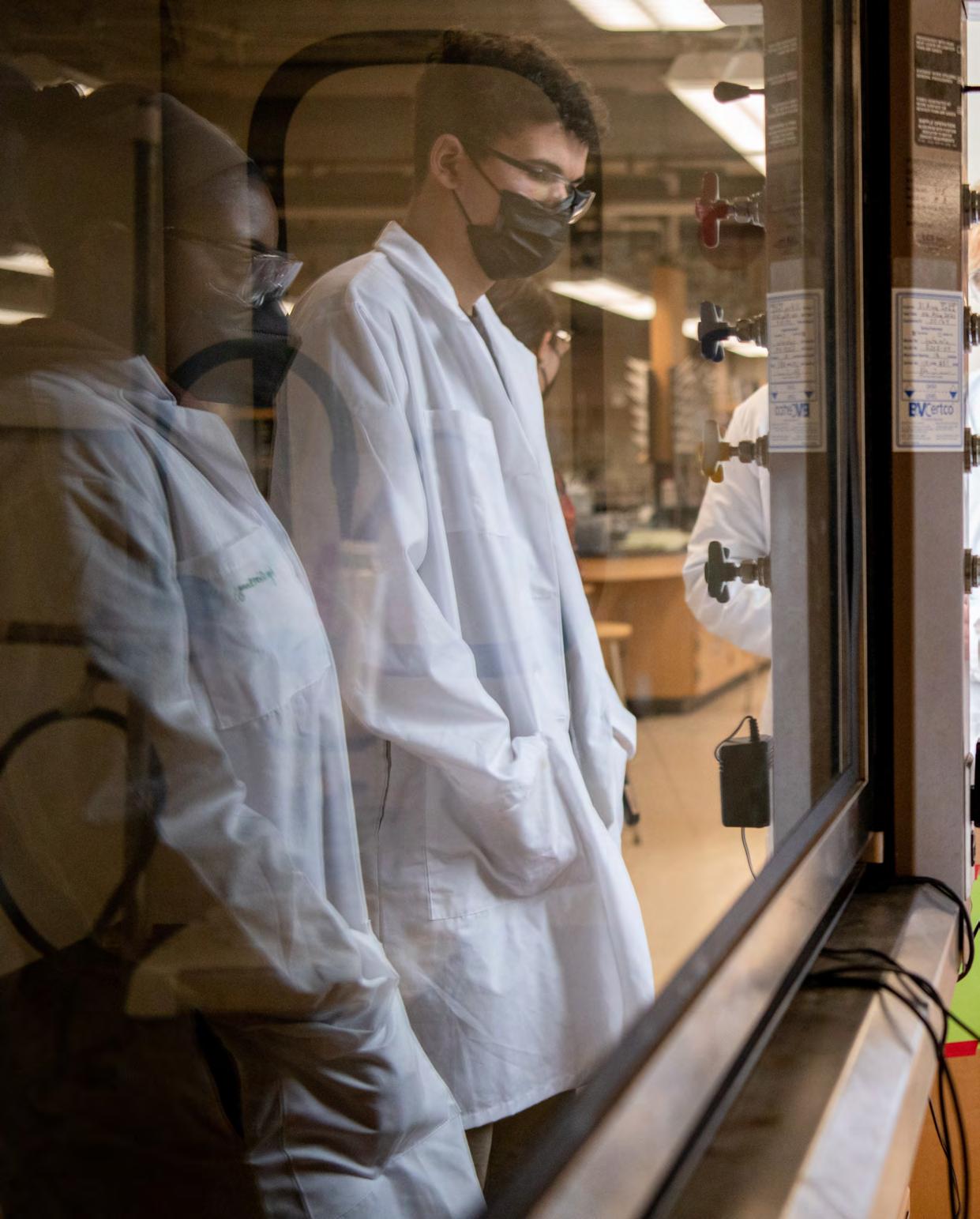
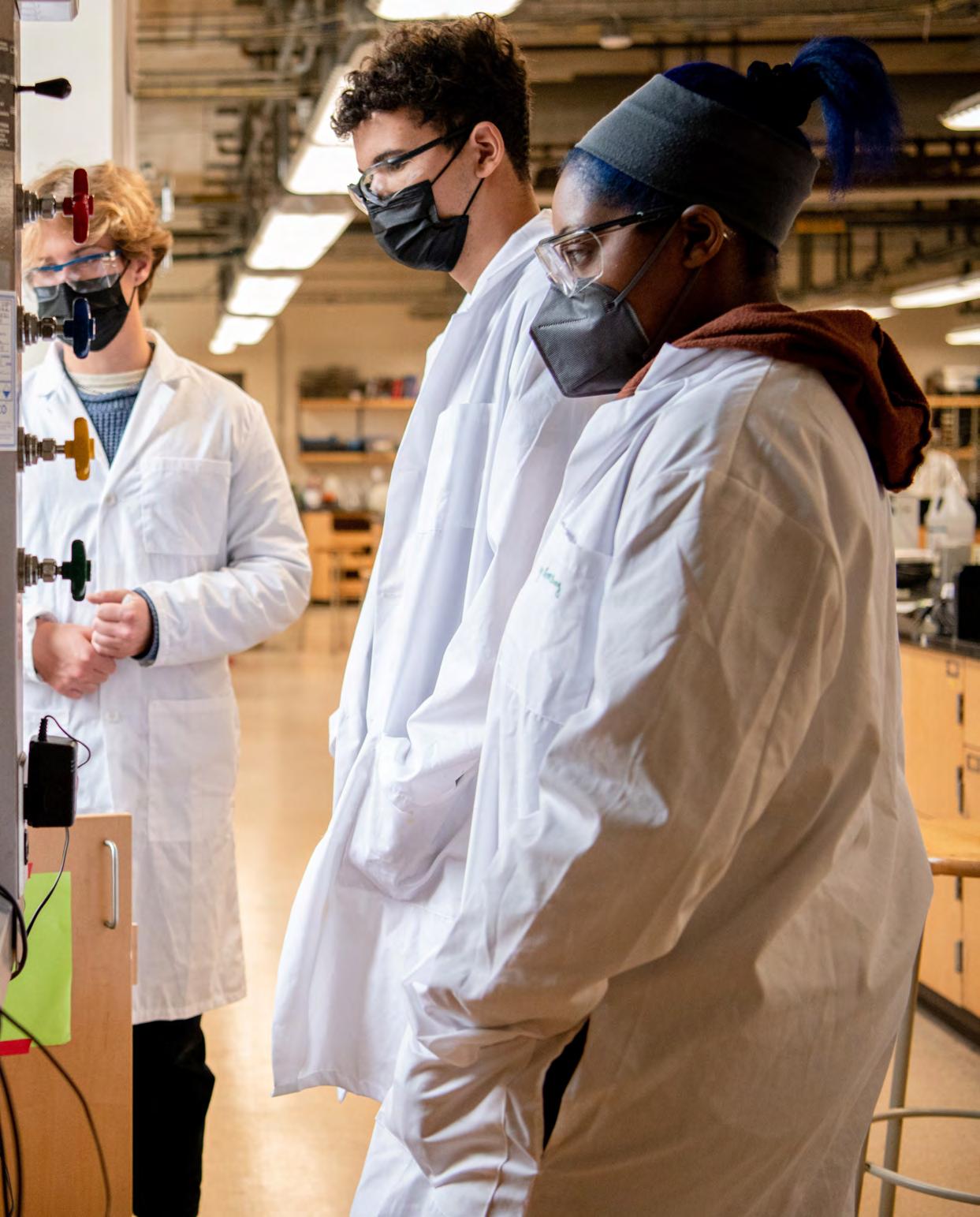
Currently, the KINSC supports the following activities:
Summer research opportunities for students, on campus or at other institutions
Fall research symposium, showcasing work by students from Haverford, Bryn Mawr, Swarthmore, and other area colleges
Travel for students to pursue research during the academic year with collaborators in labs within the U.S.A. or abroad
Travel for students to attend conferences, to present research or to gain experience applicable to future careers (in collaboration with the Green Fund)
Student and faculty training in new sciencerelated techniques
Special projects initiated by science faculty
Events such as research talks, film screenings, and panels
Annual career panel for science majors, in collaboration with the Center for Career and Professional Advising
Annual Student Scientific Imaging Contest
Mentoring and Student Teaching Program (MAST)
Research and travel for students from groups underrepresented in the sciences, through the Access and Achievement Fund

The range of programs supported by the KINSC is limited only by the imagination of the Haverford science community.The 2021 Frances Velay Women’s Science Research Fellowship recipients, from left to right: Maria Krieg ’22, Alana Ponte ’23, Karlie Pollock ’22, Ellie Kerns ’22, Silina Awad ’24, Wendy (Ping) Wen ’23, Fatima Faheem ’24, Natalie Rose Olivieri ’23, Maya Langer ’24, Bilikisu Hanidu ’23, Anna Bradley ’24 , Genevieve Dallmeyer Drennen ’22, in front of the KINSC. Photo by Patrick Montero
We are committed to supporting a wide variety of creative ideas in the sciences; students should not feel limited by the categories listed.
Awards to fund research opportunities
2021
Distribution of students in the sciences
351 Awards *
16 Frances Velay Women’s Science Research Fellowship
21 KINSC Summer Scholars
48 Off-Campus Conference
151 Summer Research with Faculty
115 Academic Year Research with Faculty
*Student research opportunities are funded through the KINSC and through individual faculty grants from the NSF, NIH, etc.
29 On-campus faculty supervising student researchers
498 Majors *
12 Astronomy & Astrophysics Majors
40 Physics Majors
75 Computer Science Majors
70 Mathematics & Statistics Majors
42 Chemistry Majors
67 Psychology Majors
90 Biology Majors
54 Environmental Studies (with BMC)
48 Neuroscience (with BMC)
*This figure captures juniors and seniors who have declared a major in the sciences. Students do not declare majors until the end of the sophomore year.
100% Science majors who graduate with research experience
$7.85 M
External funding for research by our natural science faculty
Conferences students attended with funding from the KINSC:
Ocean Science Meeting
Society for Integrative and Comparative Biology
Meeting of the American Astronomical Society
Annual Biomedical Research Conference for Minority Students

American Chemical Society
Society of the Psychological Study of Social Issues (SPSSI)
Annual Meeting of the International Society for Developmental Psychology
International Zebrafish Conference
American Association of Geographers
Society of Behavioral Medicine
APS March Meeting
Pennsylvania Association for Sustainable Agriculture Conference
Society for Neuroscience Global Connectome
Conference for Undergraduate Women in Mathematics
Conference for Undergraduate Women in Physics
Cold Spring Harbor Symposium on Neurodegeneration and Therapeutics

In the northwest corner of campus, the double-domed Strawbridge Observatory is, by day, a classroom, library, and lounge space. After sundown, however, the building opens its doors four times a semester to continue a Public Observing Program, which for years has offered a bridge between the College and the surrounding community. At the astronomy-centered gatherings, a team of Bi-Co students provide presentations, children’s programming, craft projects, and viewing of celestial objects with the observatory’s two telescopes —making for all-ages fun that anyone can enjoy.
Public Observing activities vary from night to night, but when weather permits, students locate planets, nebulas, or star clusters using the 16-inch and 12-inch telescopes that sit atop the building. Downstairs, craft activities (like building rocket ships or designing planets) are popular with the younger visitors. And after an hour or so, Haverford students practice distilling astronomical knowledge into broadly understandable terms by presenting on their research or something astronomy-related in the news.
The Mentoring and Student Teaching (MAST) program is a long-standing outreach program at Haverford College. The program provides laboratory experiences and writing tutorials for Philadelphia area middle school students who come from backgrounds traditionally underrepresented in the sciences.
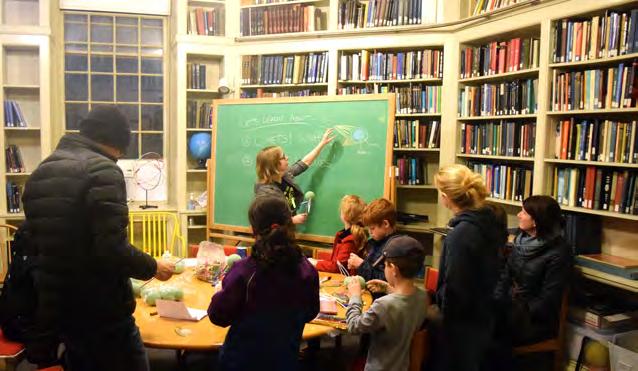
The 2021 MAST Program took place virtually with 12 students in attendance. Lab materials were mailed to each student and a virtual MAST Program was held over Zoom led by our Haverford student MAST coordinators.
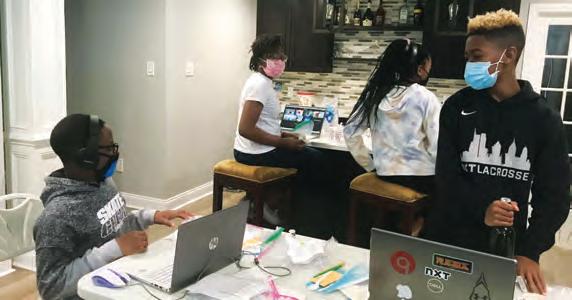
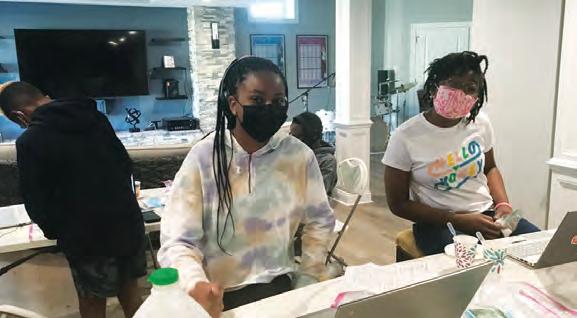
An annual showcase for student research, this year’s September event featured student talks and poster displays on topics in astrophysics, biology, chemistry, environmental studies, computer science, mathematics, physics, and psychology— spanning cognitive science and neuroscience, and even including algorithmic fairness.

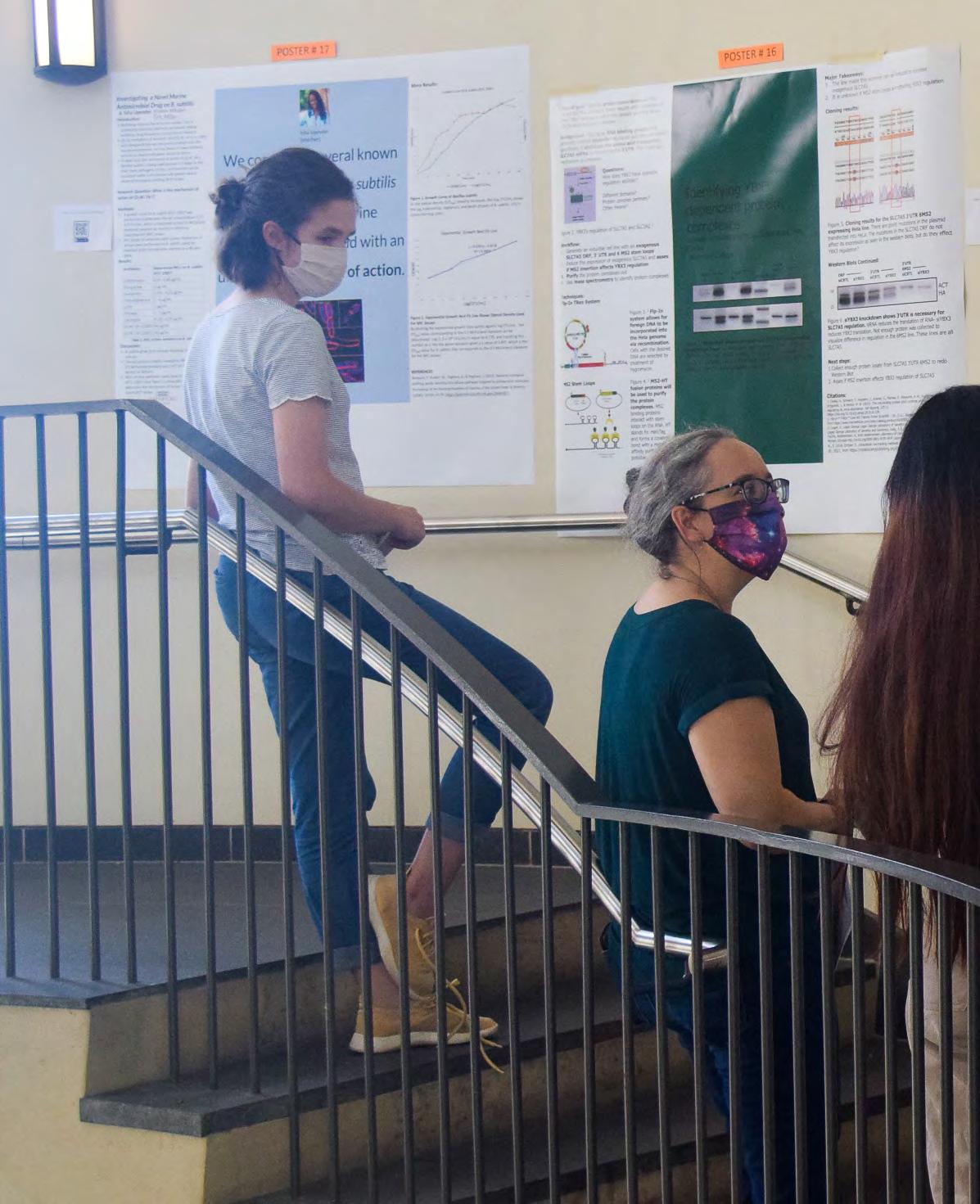
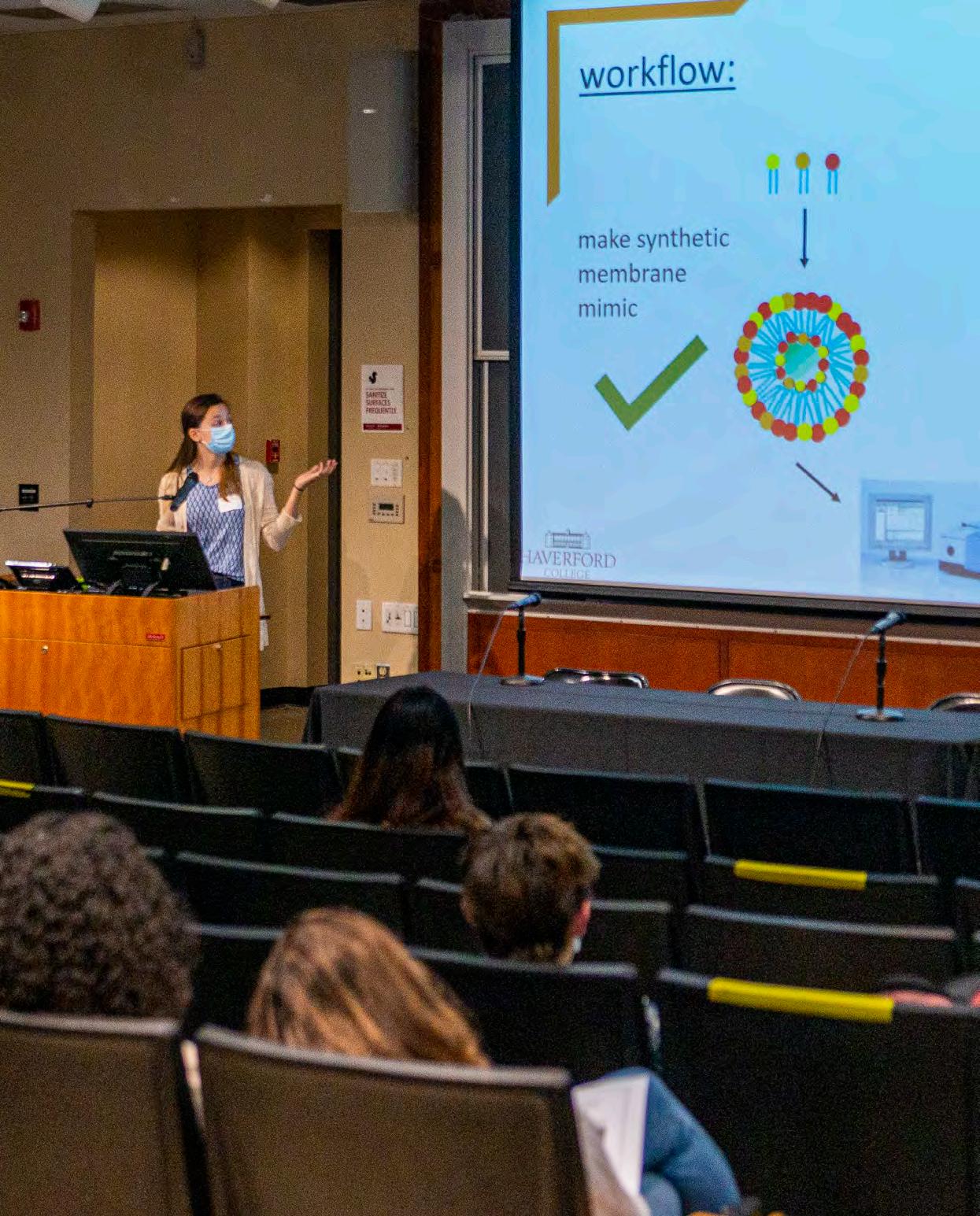
The Growing Up in Science program, a new series of informal faculty talks, aims to give Haverford’s scientists a place to speak about their career paths, personal struggles, and proudest achievements, making explicit to students the diverse journeys that have led them to their current careers. The program is hosted over Zoom and is open to any interested students.
“The series is meant to introduce faculty to the KINSC community in a new light by having them share their personal stories, setbacks, successes, detours, achievements, etc., that lead them to where they are now,” said Marielle Latrick, associate director of the KINSC and an organizer of the program.
Ryan Lei, assistant professor of psychology, was integral to the organization of the series, acting as the moderator for the first event, which was held on March 26.
“Different groups face unique challenges in pursuing STEM, so we wanted to make sure to give voice to a variety of experiences,” said Lei. “Racism, sexism, homophobia, classism, immigration status, and other forms of inequality often deter students from minoritized backgrounds from pursuing STEM careers, so it is important to create a sense of community and shared experiences where possible.”

The first installment of the Growing Up in Science series featured one of the newest members of the KINSC community, Assistant Professor of Chemistry Clyde Daly, who joined the faculty last summer. In his talk, he focused on his culture, his Christian faith and how its role in his life has changed, and the roles his race and heritage have played in his career.
Daly described his experience in life as a set of parallel paths, a set of different stories, where a choice in one impacts the choices in another.
“Some of the most important topics I discussed were where my family comes from in Montserrat and my journey with religion, and how little effect it actually had on my scientific journey,” he said. “Finally, I talked about how my scientific journey was affected by my sense of cultural isolation, but how, once that was solved, things went really smoothly.”
Daly was particularly struck by how Lei’s thoughtful questions at the event made him think of his own scientific journey in a new light.
“It made me think of my life in a more combined way than usual. It also helped me see how streamlined it has been since I figured out how to find enriching spaces for myself,” he said.
During his presentation, Daly discussed the bifurcation of his identity between that of a chemist and that of a Black man, and how at college he often tried to keep the two groups separate. He also talked about how his experiences changed as he moved from Gordon College, his undergraduate school, to the University of Notre Dame, his graduate school.
“At Gordon, I kind of bifurcated myself, I was science-y for the science people, I was a person of color for the people of color,” he said. “I think when I went to Notre Dame, the larger populations of both allowed me to join a group where I could be both, but it really only worked when I found the right group for it.”
Latrick sees that Daly’s event is the first in a long-running series, noting that organizers are aiming to hold at least one or two conversations per semester, transitioning to in-person events once health and safety guidelines allow.
Additionally, the program hopes to expand its focus to include student voices and experiences. Any student interested in participating can contact Assistant Professor Ryan Lei or Marielle Latrick for details.
The resources and facilities of the KINSC support a wide range of the interesting, unusual, and often unique courses that enrich the Haverford College experience for every student. Check out the Haverblog for more Cool Classes.




“Explaining the Universe: An Astrophysics Writing Seminar”
“Ethics and Use of Mathematics With a Focus on Antiracism”

“Encoding Music: Digital Approaches to Scores and Sound”


“Communicating Psychological Science”
“Statistical Thermodynamics and Kinetics”
“Clinical PsychoPharmacology”
“Advanced Topics: Observational Astronomy”


“Perspectives in Biology: Plants and People”


“Topics in Astrophysics: Extragalatic Data Science”

“Cancer Narratives”
“Asian American Psychology”
More than 25 years after launching as a concentration and nearly a decade after offering a minor, the neuroscience program now welcomes majors from Haverford and Bryn Mawr.

The Bi-Co Interdisciplinary Neuroscience Program —which brings together perspectives from medicine, biology, and psychology, among other fields, for an in-depth study of the nervous system and behavior —has long been popular with students at Haverford and Bryn Mawr. There are currently 53 neuroscience minors across the Bi-Co, and 20 Fords expect to graduate with the minor in 2022. But, says Assistant Professor of Psychology Laura Been, who has coordinated the minor since 2016, the most common question she’s fielded from prospective students over the past five years is, “Can I major in neuroscience?” Now, the answer is finally yes.
“Given the degree of student interest and a critical mass of faculty able to offer a stable curriculum of courses on a consistent basis, the time does, indeed, seem right to introduce this new major at Haverford, putting us on par with many other institutions,” said Provost Linda Strong-Leek.
The path to becoming a major has been a long one. Neuroscience was first introduced at Haverford as a
concentration in neural and behavioral science in 1995, and became a Bi-Co interdisciplinary minor in 2013. In 2015, a working group of Haverford and Bryn Mawr faculty across biology and psychology departments began meeting, supported in part by a Mellon Foundation Brainstorming grant, to discuss the introduction of a major. And this spring the Educational Policy Committee approved the introduction of the new major.
“It has been a very intentional and deliberative process to create a major that is rigorous, inclusive, and sustainable,” said Been.
Two new classes have been added to support the major: a 100-level “Introduction to Neuroscience” class and a senior capstone course. Additionally, neuroscience majors will be required to take a semester each of introductory biology, chemistry, psychology, and statistics, as well as four credits of upper-level neuroscience courses and one lab course in neuroscience.
For students like José E. Rodríguez ’22, who had planned on minoring in neuroscience, this new program expansion allows him to rethink his major course of study. Based solely on his interests, the junior from Puerto Rico has already taken most of the new major’s prerequisites, and plans to declare a neuroscience major.
“Neuroscience is the passion I never knew I had until I came to discover it through its minor,” said Rodríguez. “I
think with its being offered as a major now, many will be interested both by its novelty and by high applicability and usefulness in life as a degree that combines exquisitely with many other minor degrees—bio, econ, chem, philosophy, linguistics, English, etc.—or as a minor in itself alongside any other major.”
Neuroscience, Been notes, is inherently a crossdisciplinary field, and the working group intentionally wanted the new major’s requirements to reflect that.
“The faculty involved in the program work on research questions that range from the cellular and molecular level to the systems and behavioral level to the cognitive level,” she said. “In the future, we hope to expand the major to include even more disciplines, including computer science, visual studies, and philosophy.”
Those faculty members include working group members Professor of Psychology Rebecca Compton, Assistant Professor of Biology Roshan Jain, Professor of Biology Rob Fairman, Bryn Mawr Assistant Professor of Psychology Laura Grafe, Bryn Mawr Professor of Psychology Anjali Thapar, and Bryn Mawr Associate Professor of Biology Greg Davis. (The working group also previously included Bryn Mawr Professor Emeritus of Psychology Earl Thomas, Bryn Mawr Professor Emeritus of Biology Peter Brodfuehrer, and Bryn Mawr Professor Emeritus of Biology Karen Grief.)
“The Bi-Co relationship is a huge strength of the Neuroscience Program,” said Been. “This was true for the minor and is especially critical for the major. It allows us to expand the number and breadth of our neuroscience course offerings, provides students with opportunities to explore different research areas and perspectives, but keeps upper-level course enrollments small enough that we can do exciting things pedagogically and methodologically.”
The program will continue to offer a minor, in addition to the major, for those students whose primary curricular interests are in different fields but also wish to pursue their interests in the brain and behavior. But for those students who have long hungered for a more in-depth course of study, this new major fulfills those aspirations.


“It means a lot to me,” said Rodríguez, “that I can finally pursue what I am actually specifically interested in.”
Who says scientists can’t be silly? Every year, senior majors in biology, chemistry, computer science, environmental studies, mathematics and statistics, physics and astronomy, and psychology—all of which are housed in campus’ Koshland Integrated Natural Sciences Center (KINSC)—take a break from their studies and pull a prank for April Fools’ Day. Students in each department pick a theme, and overnight, transform their section of the sprawling KINSC with handmade decorations. This year, they took inspiration from animated movies—including Shrek, Ratatouille, and Space Jam—video games, and The Hunger Games.
Three Haverford alumni who are pursuing or will be pursuing graduate studies in microbiology, genetics, and cultural anthropology have received awards this year from the National Science Foundation Graduate Research Fellowship Program (NSF GRFP). The oldest graduate fellowship of its kind, the NSF GRFP provides a three-year annual stipend of $34,000 and a $12,000 cost-of-education allowance for tuition and fees, as well as opportunities for international research and professional career development. This year, the NSF offered graduate research fellowships to 2193 students pursuing research-based master’s or doctoral degrees at institutions in the United States. Among them are Joie Ling ’20, Abi Mumme-Monheit ’20, and Camille Samuels ’21.

Ling has spent the two years since her Haverford graduation as a post-baccalaureate research fellow at the National Institute of Allergy and Infectious Diseases, studying the role of quorum-sensing in gram positive bacteria pathogenesis
in the host gut. The NSF GRFP will support her research in the Microbiology Doctoral Training Program at University of Wisconsin-Madison, where she is matriculating this fall.
“While my graduate project is not set yet, I aim to research microbial pathogenesis and microbe-host interactions, on a molecular/chemical level,” she said. “While my research will be a big component of my time in graduate school, I also plan on continuing my work focused on increasing science accessibility for all ages and populations during graduate school and beyond.”
At Haverford, Ling majored in chemistry, minored in health studies, and concentrated in biochemistry. She worked in Professor of Chemistry Casey Londergan’s lab under the joint mentorship of Londergan and Associate Professor of Chemistry Lou Charkoudian.
The National Science Foundation recognized recent grads with awards to support their graduate education and research.
“My time at Haverford has had an immense influence on me and how I approach my science,” she said. “The interdisciplinary nature of my studies has trained me to look at problems with multiple perspectives and to place those problems in context of larger systems. Being able to think in context not only aids my research, it enables me to be a good science communicator and to keep my science accessible. Haverford has taught me how science does not and cannot operate in a vacuum and critical thought must always be given to how science interacts with the rest of society.”
Mumme-Monheit is in her second year of a graduate program at the University of Colorado, Anschutz Medical Campus, where she is researching developmental genetics in Jamie Nichols’ lab.
“In my research, I am using a zebrafish model to investigate the mechanisms of incomplete penetrance,” she said. “Incomplete penetrance is when some individuals are dramatically affected by a deleterious mutation, and others are resilient to it. It’s a phenomenon that has long perplexed geneticists, and this fellowship will fund my current research investigating factors that regulate incomplete penetrance.”
Mumme-Monheit hopes her Ph.D. research will lay the groundwork for a career studying other human diseases, including eventually contributing to clinical applications in areas like gene- and stem cell-based therapies.
At Haverford, Monheit majored in biology and minored in health studies, mentored by visiting assistant professors Jay Lunden and David Higgins. It was Higgins who fortified her interest in genetics and advised her senior thesis, “Investigating the Fitness Defects in Abnormal Zea mays by Studying Expression of bHLH208 in the K10L2 Haplotype.”
“Haverford allowed me to perform independent research from an early stage in my scientific career, giving me the opportunity to discover the types of work I am passionate about,” she said. “Further, community engagement is integral to the Haverford experience, and community outreach is a large portion of the NSF GRFP. At Haverford I started a non-profit CrossFit affiliate that served as a safe space for students from all backgrounds to work out in community. I have continued my fitness-based outreach in Colorado, where I now run an inclusive fitness class for LGBTQ+ middle and high schoolers.”
Samuels is also currently finishing the first year of her Ph.D. program. She studies cultural anthropology at the University of California, Irvine. The graduate research fellowship will help support the next three years of her program—about
half of its remaining length—allowing her to focus on her own coursework and research instead of working as a teaching assistant.
“Currently my research applies Black Feminist Ecological frameworks to explore the practice of abolitionist food justice in Black communities in the U.S.,” she said. “While I’ve been looking at urban gardening specifically, I am excited to expand to other forms of food production and consumption as well.”
Samuels first began that research for her Haverford senior thesis, “‘Land Is Revolution’: Unearthing the Transformative Power of Black Gardening in Washington, D.C.” Mentored by William H. and Johanna A. Harris Professor in Environmental Studies and Chemistry Helen White and Assistant Professor of Health Studies Anna West, and also supported by anthropology professors Juli Grigsby and Elena Guzman, Samuels created her own independent major in health, science, and societies and earned minors in Africana studies and environmental studies. Last year, she earned Haverford’s Clementine Cope Fellowship, a 100-year-old fellowship supporting Fords’ graduate studies.
“While I was at the College, I found that I was often encouraged to push boundaries and pursue experiences that did not necessarily line up with my academic trajectory. Having the space to adjust the curriculum in a way that nurtured my learning through my independent major was really unique! … I feel that I fully benefited from the flexibility and challenges of the liberal arts, and I bring those unique ways of learning and thinking into my graduate studies.”
An additional three Haverford members of the Class of 2020 were recognized with honorable mentions by the NSF GRFP: Sam Ditkovsly, who researches physical oceanography at Princeton; Sara Matsumura, a sustainable chemistry researcher at the University of California, Santa Barbara; and Dominick Rowan, who studies astronomy and astrophysics at Ohio State University.
“Haverford has taught me how science does not and cannot operate in a vacuum and critical thought must always be given to how science interacts with the rest of society.”
—Joie Ling ’20
Shopping for fish can be stressful. Every time I walk into a grocery store, I’m slapped with signs advertising “sustainably farmed” salmon and shrimp. But exactly how sustainable are these farmed seafoods? Are they really better than the wild caught option?
of fishing on our ocean’s entire ecosystem.
Both parthenotes were male, which also supports their conclusions. The sex of bird species is deter mined by their combination of sex chromosomes: males have ZZ sex chromosomes, and females have ZW. Thus, female eggs will either contain a W chromosome, and the offspring from par thenogenesis will be either ZZ or WW. Since the Z chromosome is critical for survival, all viable off spring from parthenogenesis will be ZZ and there male.
A CATALOG OF EDIBLE FUNGI ON HAVERFORD’S CAMPUS
Oscar Garrett
is a student-led, open-access magazine that provides accessible science journalism to the Haverford community. Jolt publishes both student and faculty writing, reporting on recent scientific advancements, research, and discoveries around the world and within the College. Founded as a digital publication is expanding in 2022 to include
Aquaculture is also vital to our economy. 50% of seafood consumed by humans is produced in aquaculture, and this is predicted to in crease in future years. The global aquaculture industry itself was worth $285,359.7 million in 2019 and is projected to be worth $378,005.5 millon by 2027 (Lester et al., 2018). The in dustry itself is an opportunity for economic development and job creation as the fastest growing food production industry in the world.

new industry in the U.S. and hasn’t mized to control disease or contain Natural livestock feed like garlic promise in improving fish and shrimp systems, which would prevent bacterial tions while minimizing antibiotic (Militz et al., 2013). Additionally, vations like weather-resistant marine sures and expansive land facilities developed to prevent non-native escaping enclosures (Monterey
Disclaimer: Foraging is a fun hobby with tasty rewards, but it can result in injury or death with the of ignorance and misfortune. Do not eat anything you find without being sure of its identity. The article are intended to help learn about, not identify, the fungi on campus. Consult a field guide before consuming any wild edibles.
One criticism of aquaculture is that it risks introducing non-native species into certain ocean regions. For example, China’s native carp species is nearly extinct due to the ac cidental release of non-native cultured carp (Zhang et al., 2015). Another problem is that farmers often supplement fish with drugs like antibiotics, giving rise to antibiotic-resistant bacteria. When humans come into contact with these bacteria, consequent illnesses can be difficult to treat. Antibiotic resistance caus
It seems there is truth in labels terms like “sustainable” farmed are certainly improvements to the aquaculture industry to reduce ative effects it can have on the and human health, but I believe step towards a healthier ocean ic growth. How will your dinner now that you’ve read about sustainable
Once you enter the strange yet magnificent world of fungi, you will never look at the forest floor be looking at it a whole lot more. Fungi are a very diverse kingdom, ranging from single-cellular mentation) to the largest organism on earth (a giant honey mushroom colony in Oregon, spanning Multicellular fungi can be filamentous, composed of tube-like cells called hyphae. These hyphae called mycelium, which constitutes the vast majority of the fungi’s body mass. Some of these a fruiting body, called a mushroom, whose function is to spread the fungi’s spores.
There are hundreds of thousands of characterized mushrooms, and they are extremely diverse sizes, and biochemistry. Humans have been utilizing mushroom biochemistry for millennia. The given to the mummified remains discovered in the Ötztal Alps of a human dated to have lived ago) was found with Chaga mushroom and birch polypore. These fungi are known for their firestarting dicinal properties, respectively. Fungal biochemistry continues to be used extensively today, both
Each mushroom I discuss here is a species I have personally found on Haverford’s campus, and en a few of them. However, do not eat any foraged mushrooms you aren’t completely confident identify. That being said, many of these look quite unlike any toxic mushrooms and are relatively
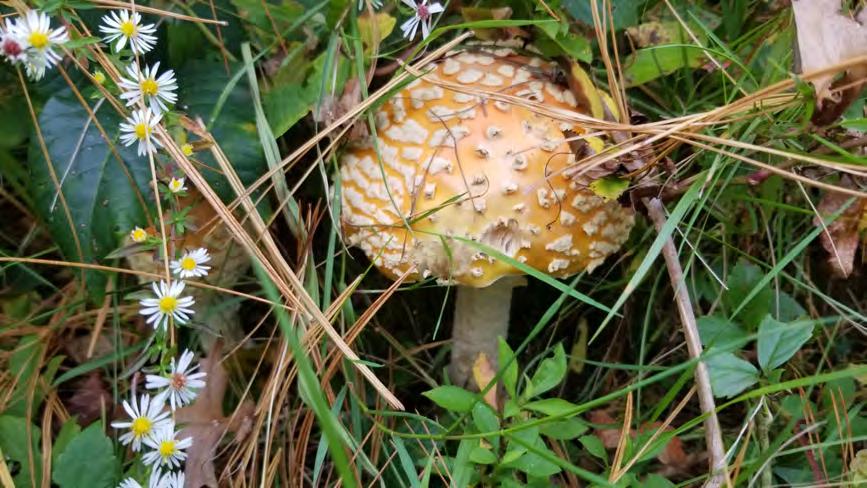
Haverford’s student-led STEM publication
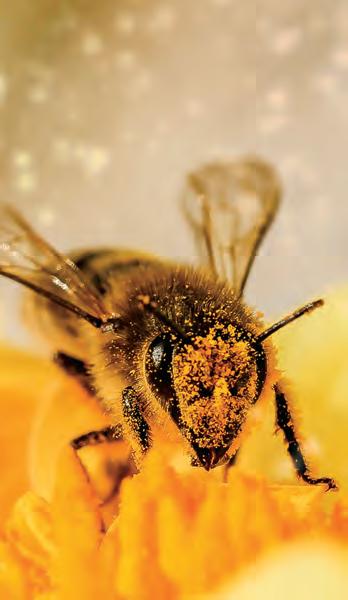
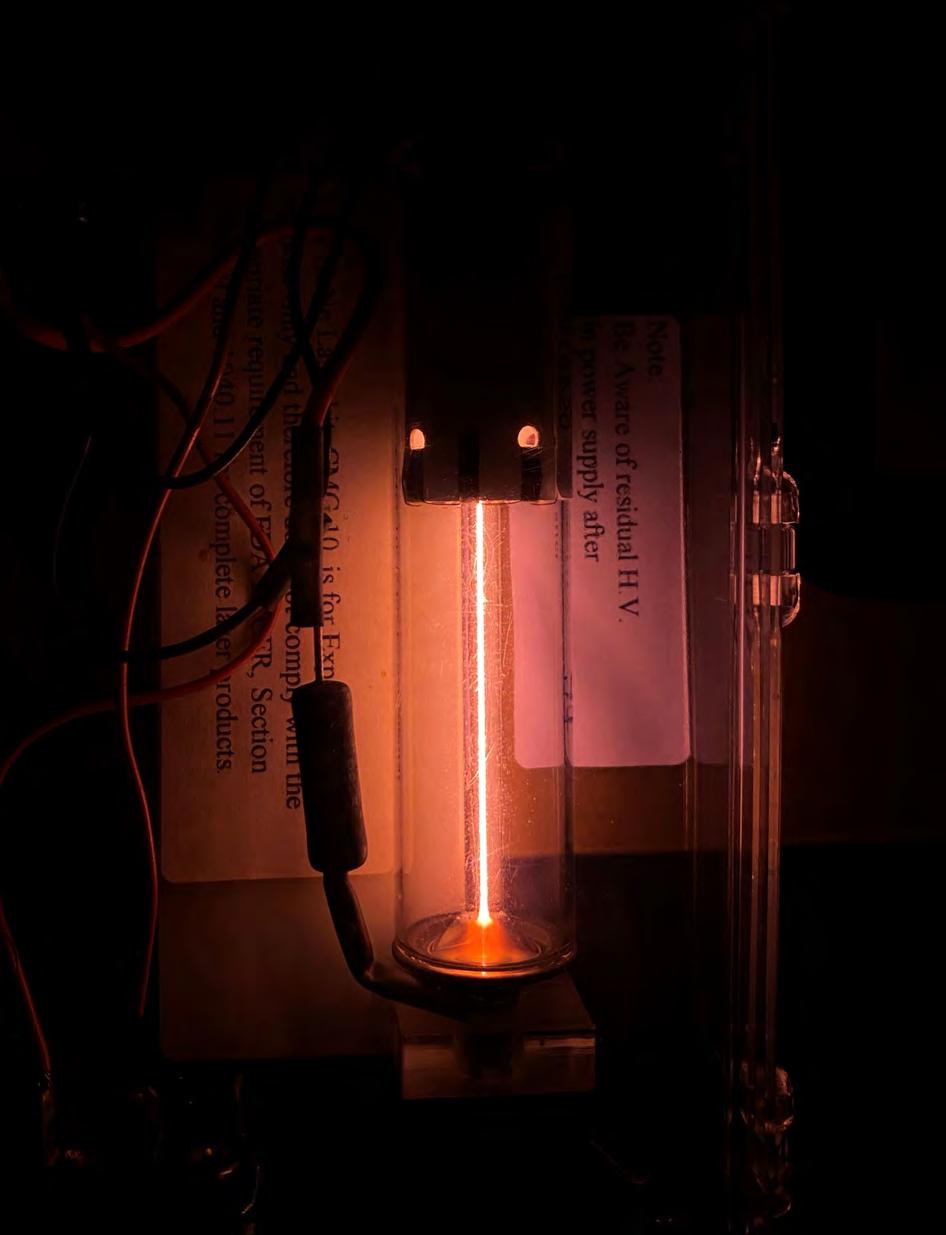

These instances of parthenogenesis in Califor condors were unusual because they were in

The Haverfarm is a year-round farming and educational space designed to integrate sustainable food and agriculture into the academic and extracurricular lives of Haverford students, faculty, staff, and community members. With a focus on interdisciplinary and experiential learning, the Haverfarm invites students and other members of the community to engage with issues of food justice and local, progressive agriculture.

KINSC Staff
Karen Masters
Director, Koshland Integrated Natural Sciences Center, Professor of Physics and Astronomy
Marielle Latrick
Associate Director, Koshland Integrated Natural Sciences Center
KINSC Steering Committee
Joanne Brown Science Stockroom Manager
Ryan Lei Assistant Professor of Psychology
Alexander Molot Director, Academic Resources and Foundation Relations
Kristen Whalen Assistant Professor of Biology
Cover image: Charlotte Park BMC ’22 Earth terms in pulsar timing residuals simulated using Libstempo